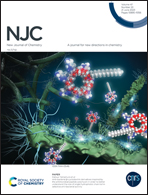Facile fabrication of a printable conductive self-healing hydrogel for human motion and electrocardiogram monitoring†
Abstract
Conductive self-healing hydrogels (CSHs) are a class of materials that possess both electrical conductivity and the ability to autonomously repair mechanical damage. These materials have potential for use in various applications, such as flexible electronics, soft robotics, and biomedical devices. However, the majority of CSHs currently rely on doped conductive media to achieve conductivity, which often leads to dopant agglomeration and limits their mechanical properties. This study presents a facile approach for synthesizing a reduced graphene oxide/polyvinyl alcohol CSH hydrogel with superior dispersibility (PVA/Agar-rGO). We synthesize rGO directly in the polymer solution using an alkaline heat-reduction technique to improve its dispersibility, which results in superior conductivity. PVA/Agar-rGO is structured through a double network gel system of PVA and agarose, which also enables excellent self-healing properties. The PVA/Agar-rGO gel demonstrates potential as an ECG electrode, producing clear waveforms with good signal strength and low baseline noise. Additionally, it can function as a printable motion sensor, capable of resolving spatial signals in two directions. This work highlights a novel and promising approach for developing CSHs with potential biomedical and wearable electronics applications.



 Please wait while we load your content...
Please wait while we load your content...